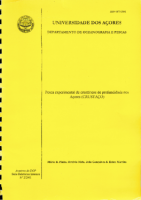Pesca experimental de crustaceos de profundidade nos Açores (CRUSTAçO). Arquivos do DOP, Serie Relatorios Internos n° 2/2001, 82 p

This work aims to increase knowledge on the biology and fishing of the macro-crustaceans of the Azores, mainly of the species of crabs (Cancer bellianus and Chaceon affinis) and shrimp (mainly of the family Pandalidae) that have been little explored commercially.
For this purpose, the current Azorean fishery of crustaceans was characterized, using fishing landings information and data from commercial fishing vessels' observers. For the analysis of the biological characteristics of the resources, research cruises were carried out using trap webs with a random stratified sampling design.
The results show that the current crustaceans fishery is mainly fishing lobster (Palinurus elephas) and cavaco (Scyllarides latus), occasionally catching sapateira (Cancer bellianus). The latter is not a target species of the Azorean fishery due to market problems. The crustaceans with commercial interest in the Azores are distributed in communities differentiated according to the depth in three major strata: coastal (<200m), intermediate (200-700m) and deep (>700m). The target species of this study dominate each of these strata: cavaco and lobster in the littoral, sapateira in the intermediate strata and deep crab in the deep strata. For shrimp species the same type of distribution can be defined: coastal (Plesionika narval), intermediate (Plesionika edwardsii, Ligur ensiferus, Heterocarpus ensifer, Plesionika ensis) and deep (Heterocarpus grimaldii and Heterocarpus laevigatus). This type of distribution allows for directed fishing, capturing species characteristic of each stratum (coastal, intermediate and deep). The variability of yields is high for all species and seems to be associated with the type of distribution by "aggregations", as a consequence of the habitat preferences of each species (mainly the type of substrate).
Results of the individual biology of the resources are presented, the fishing potential of each species is discussed and some recommendations for management are presented.







